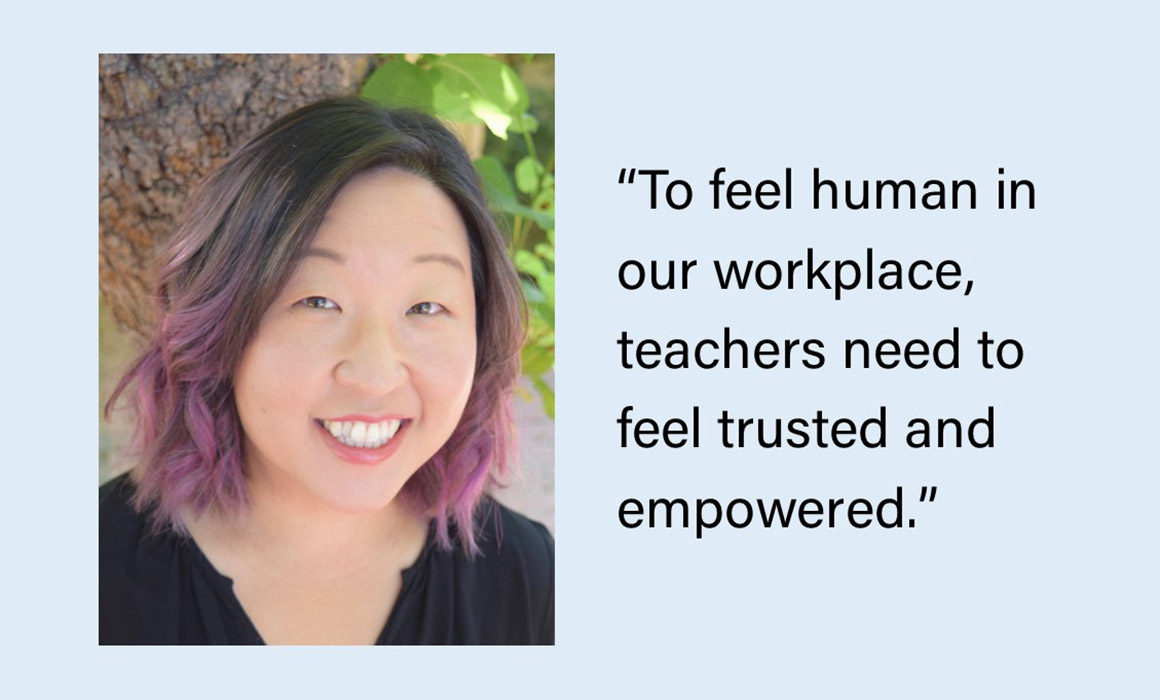
“This has been the worst semester of my career.”
It was the third time that day I heard a teacher express this sentiment.
“I didn’t think anything could be worse than distance learning, but somehow this year has been harder.”
Sitting in my office, I listened to this teacher who has been teaching and coaching for 23 years. She is that beloved teacher who is always willing to engage and re-engage in the work, even when things are difficult and morale is low. If this joyful canary is singing a frustrated tune in the coal mine, we must listen.
As an instructional coach, the most important role I have is as a listener. The best part of my job is bearing witness to the deep self-reflection that leads to perspective shifts and instructional changes. So I listened as teachers articulated what has been making this school year so difficult.
Even though teaching from home introduced new challenges for teachers across the country, it also gave many a break from all the nonteaching tasks that get piled on their plates: campus supervision, submitting unnecessary paperwork, lengthy observation and evaluation processes, maintaining and often cleaning physical classrooms, and seemingly constant fire/earthquake/active shooter drills. For many educators, coming back to in-person instruction also meant coming back to all the daily frustrations we experienced before the pandemic. But this year, we just don’t have the patience for it anymore.
Teaching through the pandemic — online, in person or hybrid — took a toll on teachers. One teacher I work with, Maria, confessed she was angry and bitter by the end of last school year. Her students stopped turning on their cameras and stopped responding despite her best efforts to keep them engaged. Without seeing faces or hearing voices, her empathy diminished. She felt disconnected and demoralized. She said she felt like a machine just pushing out work for students to do. This was something I heard over and over again. We have all expressed the same phenomenon of being dehumanized in our work as educators.
We are not just educators, of course. We are mothers of multiple school-age children, parents of students with special needs, individuals with anxiety disorders exacerbated by the worldwide anxiety of the pandemic. We are human, too. While we transform our schools into welcoming spaces, we must also make them a human place to work. We can’t forget that we saw each other’s humanity and shared a universal human experience, and then return to business as usual. We must make schools human again.
How do we do that? In my role, I’ve heard what teachers need. This is what they are asking from their colleagues, administrators and communities.
1. Avoid toxic positivity. Toxic positivity is the belief that no matter how bad a situation is, we should all have a positive mindset about it. Toxic positivity rejects or refuses to acknowledge how difficult things can be. This message is for administrators in particular.
To humanize schools, listen to and validate the real emotions teachers are bringing to campus, even the negative ones. Don’t just talk about “moving forward” when the pandemic is still playing out in the world and in our minds. Don’t just say that we must have a positive attitude for our students. Rather, give us real support, such as applying schoolwide policies with consistency and fidelity, creating schedules that allow for collaboration, and ensuring that evaluations are meaningful. Follow through on your promises and create a working environment built on trust — in each other’s competence and in one another’s commitment to our students.
2. Give teachers the professional development they want. Throughout the 2020-21 year, the instructional support team at my school site offered professional learning sessions twice a week. Sometimes we had an agenda, sometimes it was a virtual open office for teachers to show up and ask questions.
Even though sessions were voluntary, we consistently saw the majority of teachers show up to learn. I do not hold to the essentialist thinking that puts teachers into categories of “will participate” or “won’t participate” in professional development. Rather, I follow the “context principle” as discussed in The End of Average by Todd Rose.
The principle is: “Individual behavior cannot be explained or predicted apart from a particular situation, and the influence of a situation cannot be specified without reference to the individual experiencing it.” In other words, the question is not “How do we get teachers to participate in professional development?” but rather “How can we create a context in which everyone will want to engage in professional learning?”
To feel human in our workplace, we need to feel like we have choices, and teachers need to feel trusted and empowered to make those choices.
3. Systemic change, not “self-care.” We need to stop telling demoralized, tired teachers to “take care of themselves” when what they are really asking for is systemic change. Yes, teacher appreciation gifts are nice, but I’ll take a good flow chart, a clearly articulated process or a problem-solving protocol over a branded water bottle any day.
When teachers are communicating that they feel “burnt out,” they are often really expressing demoralization. Researcher Doris Santoro, author of Demoralized: Why Teachers Leave the Profession They Love and How They Can Stay, explains that demoralization occurs when teachers “encounter consistent and pervasive challenges to enacting the values that motivate their work.”
I often ask teachers, “What makes you tired?” Their answers are almost never about the students. They are about the bureaucracy: inconsistent communication, policies that don’t make sense, or the never-ending parade of initiatives they are expected to implement. You may be able to combat burnout with self-care practices, but you cannot fight demoralization with a gift card or a spa day. We must bring a critical eye to our schools’ systems and practices — and be willing to change things for the better.
4. Go beyond “checking in” to building a culture of relational trust. We cannot ask teachers to build strong positive relationships with their students without making the effort to do the same among school staff. In fact, educational leadership experts say that culture is always at play in a school’s success or failure. And research indicates that building trust among staff makes them more successful when it comes to implementing best practices over time.
This may begin with getting to know one another, but it must be a constant, concerted effort.
Last year, I helped coordinate grief counseling sessions and devoted meeting time for reflection and acknowledging feelings. Then a colleague said to me, “I think we just need to have fun together again.” So, I took on a new role I like to think of as my school’s “cruise director of fun.” One teacher called me the Julie McCoy of my school (a reference to the ’70s TV show The Love Boat — I had to look this up). I organized virtual happy hours where we played trivia games and sang karaoke. I thoroughly enjoyed watching maintenance staff and coaches come up with the 10 most recent Sexiest Men Alive according to People magazine to clinch a win for their trivia team. This kind of frivolity may seem like just that, frivolity. But ultimately, making the time to have fun together builds trust and creates a more human workplace.
Lastly, to make schools human again, we must, on an individual level, commit to being human at work. We must bring our whole selves to work and be human in front of our colleagues and our students.

1997 band photo of Jennifer Yoo‑Brannon’s husband.
The picture in this article is a 1997 band photo of my husband, who is a high school English teacher. During spring 2021, students returned to in-person classes once a week for an advisory period, a nonacademic class designed to provide a space for building relationships. He took his ninth graders on a tour of the school to reacquaint them with the building, and to make things a little more interesting, he hid several copies of that band photo along the route. If students spotted one, they could keep it. It was his way of telling them, “I was in ninth grade once too. It will be OK.” The students loved it and asked for more copies. Now, he gives these out randomly as rewards.
So, this year, this incredibly challenging academic year, we must center our humanity at work. This is what it means to be human at work — acknowledging the connections between us. There are so many dehumanizing workplaces.
We cannot let schools be those spaces.
Jennifer Yoo-Brannon is a member of El Monte Union Educators Association. A version of this essay was first published on edsurge.com.
The Discussion 0 comments Post a Comment